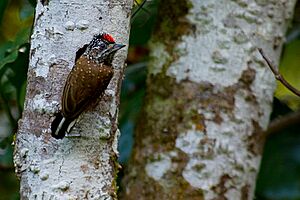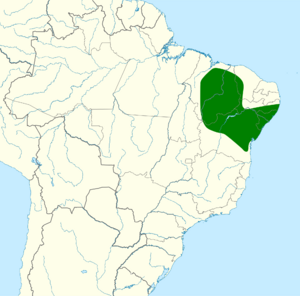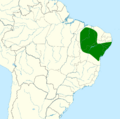Spotted piculet facts for kids
Quick facts for kids Spotted piculet |
|
|---|---|
 |
|
| Conservation status | |
| Scientific classification | |
| Genus: |
Picumnus
|
| Species: |
pygmaeus
|
 |
|
The spotted piculet (Picumnus pygmaeus) is a tiny bird that belongs to the woodpecker family. It's a special kind of woodpecker called a piculet. This bird is found only in Brazil, which means it's endemic to that country. Imagine a bird that lives nowhere else in the world!
Contents
About the Spotted Piculet
What Does It Look Like?
The spotted piculet is a small bird, only about 10 centimeters (4 inches) long. That's about the size of your hand!
Male and female spotted piculets look very similar, but there's one small difference.
- Males: They have a black cap on their head with a cool red patch on their forehead. The rest of their cap has white spots. Their face is mostly dark brown with some white tips on their feathers.
- Females: They look just like the males, but they don't have the red patch on their forehead.
Both male and female piculets have dark brown feathers on their backs, with black and white tips. Their tail is black, and some of the tail feathers have white patches. Their chest and belly are usually light brown with a reddish tint, covered in large black and white spots. Young piculets look a bit duller than the adults, and their spots aren't as clear.
Where Does It Live?
The spotted piculet lives only in the northeastern part of Brazil. You can find it in areas like central Maranhão, Pernambuco, northeastern Goiás, and the very northern part of Minas Gerais.
This little bird likes to live in dry, open woodlands. It also enjoys caatinga shrublands, which are special dry forests found in Brazil.
How Does It Behave?
The spotted piculet seems to stay in the same area all year round. It doesn't migrate to other places.
Scientists don't know much about what the spotted piculet eats or how it finds its food. Its diet and hunting methods are still a mystery!
Reproduction and Life Cycle
Not much is known about how spotted piculets raise their young. People have seen them building nests in December. A female was also seen feeding a grown chick in October.
What Does It Sound Like?
The spotted piculet has a very unique voice!
- One person described its call as a "very high-pitched, squeaky 'tsirrrrr, tsi, tsi, tsi'."
- Another said it sounds like a "very high, descending, fast, shivering trill 'ttrrrruh'."
Conservation Status
The IUCN (International Union for Conservation of Nature) has listed the spotted piculet as a species of "Least Concern." This means they don't think it's in immediate danger of disappearing.
Even though it has a large area where it lives, we don't know how many spotted piculets there are or if their numbers are growing or shrinking. There aren't any big threats to the species right now. It's possible that we don't know much about them because they are uncommon, or maybe they are just very good at hiding!
Images for kids




